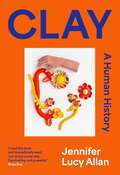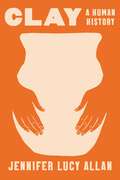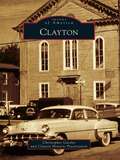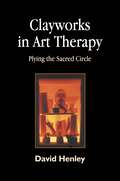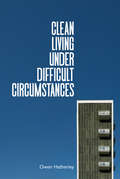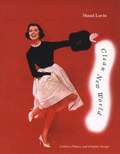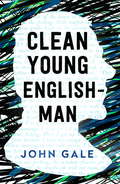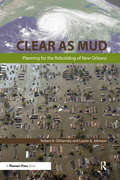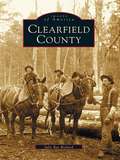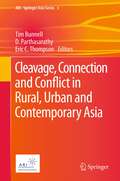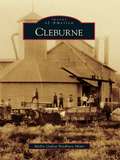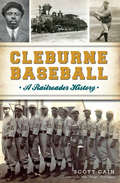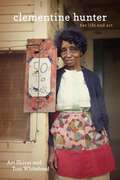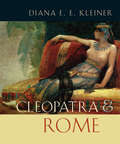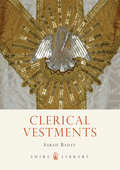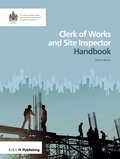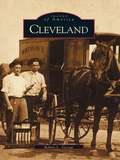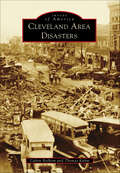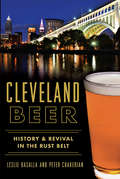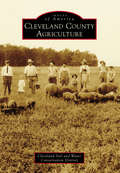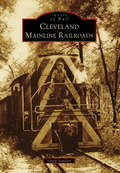- Table View
- List View
Clay: A Human History
by Jennifer Lucy Allan'Clay contains infinite possibilities in its transmutations, evidenced on the shelves of our homes, our galleries and museums. Every time we make something with clay, we engage with the timelines that are in the material itself, whether it was dug from a clifftop, riverbed or pit. In firing what we make, we bestow the material with function, meaning, or feeling, and anchor its form in a human present... Objects made from clay contain marks of our existence that collectively tell the story of human history more completely than any other material. There is a reason there are so many pots in museums: because fired clay is one of the most effective keepers of stories we have.'This book is a love letter to clay, the material that is at the beginning, middle and end of all of our lives; that contains within it the eternal, the elemental, and the everyday.People have been taking handfuls of earth and forming them into their own image since human history began. Human forms are found everywhere there was a ceramic tradition, and there is a ceramic tradition everywhere there was human activity. The clay these figures are made from was formed in deep geological time. It is the material that God, cast as the potter, uses to form Adam in Genesis. Tomb paintings in Egypt show the god Khnum at a potter's wheel, throwing a human. Humans first recorded our own history on clay tablets, the shape of the characters influenced by the clay itself. The first love poem was inscribed in a clay tablet, from a Sumerian bride to her king more than 4000 years ago. Born out of a desire to know and understand the mysteries of this material, the spiritual and practical applications of clay in both its micro and macro histories, Clay: A Human History is a book of wonder and insight, a hybrid of archaeology, history and lived experience as an amateur potter.
Clay: A Human History
by Jennifer Lucy Allan'Clay contains infinite possibilities in its transmutations, evidenced on the shelves of our homes, our galleries and museums. Every time we make something with clay, we engage with the timelines that are in the material itself, whether it was dug from a clifftop, riverbed or pit. In firing what we make, we bestow the material with function, meaning, or feeling, and anchor its form in a human present... Objects made from clay contain marks of our existence that collectively tell the story of human history more completely than any other material. There is a reason there are so many pots in museums: because fired clay is one of the most effective keepers of stories we have.'This book is a love letter to clay, the material that is at the beginning, middle and end of all of our lives; that contains within it the eternal, the elemental, and the everyday.People have been taking handfuls of earth and forming them into their own image since human history began. Human forms are found everywhere there was a ceramic tradition, and there is a ceramic tradition everywhere there was human activity. The clay these figures are made from was formed in deep geological time. It is the material that God, cast as the potter, uses to form Adam in Genesis. Tomb paintings in Egypt show the god Khnum at a potter's wheel, throwing a human. Humans first recorded our own history on clay tablets, the shape of the characters influenced by the clay itself. The first love poem was inscribed in a clay tablet, from a Sumerian bride to her king more than 4000 years ago. Born out of a desire to know and understand the mysteries of this material, the spiritual and practical applications of clay in both its micro and macro histories, Clay: A Human History is a book of wonder and insight, a hybrid of archaeology, history and lived experience as an amateur potter.
Clay: A Human History
by Jennifer Lucy AllenA human history told through clay—and how it has shaped us from ancient times to the present day. This book is a love letter to clay, the material that is at the beginning, middle and end of all of our lives; that contains within it the eternal, the elemental, and the everyday. People have been taking handfuls of earth and forming them into their own image since human history began. Human forms are found everywhere there was a ceramic tradition, and there is a ceramic tradition everywhere there was human activity. The clay these figures are made from was formed in deep geological time. It is the material that God, cast as the potter, uses to form Adam in Genesis. Tomb paintings in Egypt show the god Khum at a potter's wheel, throwing a human. Humans first recorded our own history on clay tablets, the shape of the characters influenced by the clay itself. The first love poem was inscribed in a clay tablet, from a Sumerian bride to her king more than 4000 years ago. Born out of a desire to know and understand the mysteries of this material, the spiritual and practical applications of clay in both its micro and macro histories, Clay: A Human History is a book of wonder and insight, a hybrid of archaeology, history and lived experience as an amateur potter.
Clayton (Images of America)
by Clayton Historic Preservation Christopher GasslerThe area now known as Clayton was settled shortly before the American Revolution by Jacob Fisler, the son of a Swedish immigrant. Fisler's land grew to become known as Fislertown, later renamed Fislerville, and in 1864 was deemed Clayton. Jacob Fisler and his business partner, Benjamin Beckett, began the manufacturing of glass in this new town. Clayton's glassblowing industry has had many names, from Moore's to Pierce to Clevenger, and was the heart and soul of the community for well over 100 years. While some of Clayton's historic buildings have fallen victim to the hands of progress, many remain and are inhabited by new businesses, which grow and thrive in this small community. Much has changed in Clayton, yet it continues to be a proud community.
Clayworks in Art Therapy: Plying the Sacred Circle
by David HenleyClay is universally recognized as a medium of creative expression, and it also has great potential for therapeutic application. These two properties of clay are celebrated together in a book that explores the history, theory and techniques of claywork in eliciting therapeutic outcomes. Vignettes and case material explain and expand the text, which interweaves an appreciation of clay in art with many practical suggestions for its use in therapy. By according equal status to aesthetic outcomes and artistic integrity, the author offers a new and holistic approach to claywork. Practitioners and educators in the fields of therapy and art will find his book to be an essential source of information and ideas.
Clean Living Under Difficult Circumstances: Finding a Home in the Ruins of Modernism
by Owen HatherleyHow to make a fairer, more just cityFrom the grandiose histories of monumental state building projects to the minutiae of street signs and corner cafés, from the rebuilding of capital cities to the provision of the humble public toilet, Clean Living under Difficult Circumstances argues for the city as a socialist project. This essay collection spans a period from immediately before the 2008 financial crash to the year of the pandemic. Against the business-as-usual responses to both crises, Owen Hatherley outlines a vision of the city as both a venue for political debate and dispute as well as a space of everyday experience, one that we shape as much as it shapes us. Incorporated here are the genres of memoir, history, music and film criticism, as well as portraits of figures who have inspired new ways of looking at cities, such as the architect Zaha Hadid, the activist and urbanist Jane Jacobs, and thinkers such as Mark Fisher and Adam Curtis. Throughout these pieces, Hatherley argues that the only way out of our difficult circumstances is to imagine and try to construct a better modernity.
Clean New World: Culture, Politics, and Graphic Design
by Maud LavinOur culture is dominated by the visual. Yet most writing on design reflects a narrow preoccupation with products, biographies, and design influences. Maud Lavin approaches design from the broader field of visual culture criticism, asking challenging questions about about who really has a voice in the culture and what unseen influences affect the look of things designers produce. Lavin shows how design fits into larger questions of power, democracy, and communication. Many corporate clients instruct designers to convey order and clarity in order to give their companies the look of a clean new world. But since designers cannot clean up messy reality, Lavin shows, they often end up simply veiling it. Lacking the power to influence the content of their commercial work, many designers work simultaneously on other, more fulfilling projects. Lavin is especially interested in the graphic designer's role in shaping cultural norms. She examines the anti-Nazi propaganda of John Heartfield, the modernist utopian design of Kurt Schwitters and the neue ring werbegestalter, the alternative images of women by studio ringl + pit, the activist work of such contemporary designers as Marlene McCarty and Sheila Levrant de Bretteville, and the Internet innovations of David Steuer and others. Throughout the book, Lavin asks how designers can expand the pleasure, democracy, and vitality of communication.
Clean Young Englishman
by John GaleFirst published in 1965 John Gale's autobiography is one the brilliant evocations of English life. From growing up in rural Kent to joining the Coldstream Guards and drunkenly dancing with the young Princess Elizabeth at Windsor Castle, Gale's early years seemed untroubled by darker shadows. But later, as a foreign correspondent in Algeria, Egypt and the Far East, he witnessed scenes of such horror that his comfortable world - and his sanity - were shaken to their very foundations. Witty, ironic, sharply observed and deeply moving, John Gale's memoir is a unique record of a young man struggling to make sense of the world.
Cleaning Historic Buildings: v. 2
by Nicola AshurstWhat happens to the fabric of a historic building if it is not cleaned? What is soiling, how does it affect the building? What cleaning methods should be used? This second of a comprehensive two-volume guide addresses these important and controversial questions, along with many others, and offers practical guidance on appropriate cleaning techniques, backed up with useful case study material. Based on the author's extensive on-site involvement at trial and contract stage in many cleaning and surface repair project, this book examines the various attitudes and current cleaning practices, along with the role and need for analysis of substrates and soiling. It also offers advice on dealing with special cleaning problems, such as the removal of paint, graffiti and metallic stains, and provides an assesment of the cleaning methods currently available.
Clear as Mud: Planning for the Rebuilding of New Orleans
by Laurie Johnson Robert B. OlshanskyPlanning the rebuilding of New Orleans after Hurricanes Katrina and Rita has been among the greatest urban planning challenges of our time. Since 2005, Robert B. Olshansky and Laurie A. Johnson, urban planners who specialize in disaster planning and recovery, have been working to understand, in real time, the difficult planning decisions in this unusual situation. As both observers of and participants in the difficult process of creating the Unified New Orleans Plan, Olshansky and Johnson bring unparalleled detail and insight to this complex story. The recovery process has been slow and frustrating, in part because New Orleans was so unprepared for the physical challenges of such a disaster, but also because it lacked sufficient planning mechanisms to manage community reconstruction in a viable way. New Orleans has had to rebuild its buildings and institutions, but it has also had to create a community planning structure that is seen as both equitable and effective, while also addressing the concerns and demands of state, federal, nonprofit, and private-sector stakeholders. In documenting how this unprecedented process occurred, Olshansky and Johnson spent years on the ground in New Orleans, interviewing leaders and citizens and abetting the design and execution of the Unified New Orleans Plan. Their insights will help cities across the globe recognize the challenges of rebuilding and recovering after disaster strikes.
Clearfield County (Images of America)
by Julie Rae RickardClearfield County recalls the early days in the area's history when log drives filled the West Branch of the Susquehanna and the woods were occupied by lumbermen. Through these historic photographs, witness the growth of Curwensville, Clearfield, and DuBois despite terrible floods and fires. In the 1900s, the area became well known for its coal towns, quarries, the Gearhart Knitting Machine, and businesses such as Kurtz Brothers, Clearfield Furs, and Clearfield Cheese. The engaging photographs in Clearfield County also document how Kylertown Airport was once one of the busiest in the country and reveal how a few county residents, including Nora Waln, Philip Bliss, George Rosenkrans, and Tom Mix, found fame.
Cleavage, Connection and Conflict in Rural, Urban and Contemporary Asia (ARI - Springer Asia Series #3)
by Eric C. Thompson D Parthasarathy Tim BunnellAsia, the location of the world's fastest-growing economies, is also home to some of the fastest rates of urbanization humanity has ever seen, a process whose speed renders long-term outcomes highly unpredictable. This volume contrasts with much published work on the rural/urban divide, which has tended to focus on single case studies. It provides empirical perspectives from four Asian countries: India, Indonesia, Malaysia, and Thailand, and includes a wealth of insights that both critique and expand popular notions of the rural-urban divide. The volume is relevant not just to Asian contexts but to social scientific research on population dynamics more generally. Rather than deploying a single study to chart national trends, three chapters on each country make possible much more complex perspectives. As a result, this volume does more than extend our understanding of the interplay between cities and hinterlands within Asia. It enhances our notions of rural/urban cleavages, connections and conflicts more generally, with data and analysis ready for application to other contexts. Of interest to diverse scholars across the social sciences and Asian studies, this work includes accounts ranging from rural youth real estate entrepreneurs in Hyderabad, India, to social development in Aceh province in Indonesia, devastated by the 2004 tsunami, to the relationship between urban space and commonly held notions of the supernatural in Thailand's northern city of Chiang Mai.
Cleburne
by Mollie Gallop MimsOnce known for its cotton production and Jersey cows, Cleburne has evolved from its agricultural heritage into a diverse community. This former Civil War training camp, located near Buffalo Creek, was named for Confederate general Patrick Cleburne when it became the county seat in 1867. Just west of town, cowboys moved cattle up the Chisholm Trail before the Santa Fe Railway brought jobs and money in 1881. As lieutenant commander of the navy dirigible USS Akron, Charles Rosendahl soared over his childhood home of Cleburne in 1932. From early opera and movie houses, saloons, and congested trade days, to live theaters, parks, and modern industries, Cleburne continues to progress. Today a new economy and booming growth have emerged due to the Barnett Shale gas exploration.
Cleburne Baseball: A Railroader History (Sports)
by Foreword By Rodríguez Scott CainShortly after Cleburne landed the largest railroad shops west of the Mississippi, it set its sights on securing a professional baseball team. Against the odds, Cleburne became a Texas League town in 1906. After the first championship, the Railroaders loaded a train and left Cleburne. The town’s professional teams would amass two championships, three pennants and several legendary major league players, including Tris Speaker, before disappearing. Despite lacking a professional club, the town continued to field teams at all levels, until the Railroaders made their triumphant return in 2017. Scott Cain shares a century of Cleburne baseball, including the cowboys who gunned down fly balls to intimidate umps, the pro team that played the Chicago White Sox and the city councilman who was a scorekeeper for the Negro Leagues in the 1950s.
Cleburne County
by Wayne RupleCleburne County is strategically located between the two major cities of Birmingham and Atlanta. Once a part of Benton County, Cleburne County was officially created in 1866 by the Alabama legislature and named in honor of Gen. Patrick R. Cleburne, who served the Confederacy during the Civil War. The Talladega National Forest covers the western half of the county and includes Mount Cheaha, the highest point in the state. Cleburne County gained national notoriety in the 1840s when gold was discovered around Arbacoochee, which became one of the largest mining towns in the state. Over $5 million in gold was mined there. In the early 1900s, the area's mild climate and rich soil drew several hundred settlers from northern states who came to Cleburne County and established a wine-producing colony, Fruithurst, which produced as much as 23,000 gallons per year.
Clementine Hunter: Her Life and Art
by Art Shiver Tom WhiteheadClementine Hunter (1887--1988) painted every day from the 1930s until several days before her death at age 101. As a cook and domestic servant at Louisiana's Melrose Plantation, she painted on hundreds of objects available around her -- glass snuff bottles, discarded roofing shingles, ironing boards -- as well as on canvas. She produced between five and ten thousand paintings, including her most ambitious work, the African House Murals. Scenes of cotton planting and harvesting, washdays, weddings, baptisms, funerals, Saturday night revelry, and zinnias depict experiences of everyday plantation life along the Cane River. More than a personal record of Hunter's life, her paintings also reflect the social, material, and cultural aspects of the area's larger African American community. Drawing on archival research, interviews, personal files, and a close relationship with the artist, Art Shiver and Tom Whitehead offer the first comprehensive biography of this self-taught painter, who attracted the attention of the world. Shiver and Whitehead trace Hunter's childhood, her encounters at Melrose with artists and writers, such as Alberta Kinsey and Lyle Saxon, and the role played by eccentric François Mignon, who encouraged and promoted her art. The authors include rare paintings and photographs to illustrate Hunter's creative process and discuss the evolution of her style. The book also highlights Hunter's impact on the modern art world and provides insight into a decades-long forgery operation that Tom Whitehead helped uncover. This recent attention reinforced the uniqueness of Hunter's art and confirmed her place in the international art community, which continues to be inspired by the life and work of Clementine Hunter.
Clementon (Images of America)
by Danielle L. BurrowsNestled inconspicuously less than 20 miles east of Philadelphia, the village of Clementon once bore all the markings of an early-20th-century county seat: mills, lumberyards, a thriving charcoal industry, waterworks, locomotive access, and entrepreneurial residents. Incorporated as a borough in 1925, the town's abundant lakes and the allure of Clementon Lake Park quickly elevated Clementon's status to a popular recreational hotspot. Vacationers and residents alike recall traffic at the town's small intersections on Sunday nights as Depression-era amusement seekers headed home from weekends spent diving, boating, and picnicking. Declared "the busiest little town in South Jersey" in an early promotional film, Clementon remains etched in collective memories as a mecca of busyness and merriment.
Cleopatra and Rome
by Diana E. KleinerWith the full panorama of her life forever lost, Cleopatra touches us in a series of sensational images: floating through a perfumed mist down the Nile; dressed as Venus for a tryst at Tarsus; unfurled from a roll of linens before Caesar; couchant, the deadly asp clasped to her breast. Through such images, each immortalizing the Egyptian queen's encounters with legendary Romans--Julius Caesar, Mark Antony, and Octavian Augustus--we might also chart her rendezvous with the destiny of Rome. So Diana Kleiner shows us in this provocative book, which opens an entirely new perspective on one of the most intriguing women who ever lived. Cleopatra and Rome reveals how these iconic episodes, absorbed into a larger historical and political narrative, document a momentous cultural shift from the Hellenistic world to the Roman Empire. In this story, Cleopatra's death was not an end but a beginning--a starting point for a wide variety of appropriations by Augustus and his contemporaries that established a paradigm for cultural conversion. In this beautifully illustrated book, we experience the synthesis of Cleopatra's and Rome's defining moments through surviving works of art and other remnants of what was once an opulent material culture: religious and official architecture, cult statuary, honorary portraiture, villa paintings, tombstones, and coinage, but also the theatrical display of clothing, perfume, and hair styled to perfection for such ephemeral occasions as triumphal processions or barge cruises. It is this visual culture that best chronicles Cleopatra's legend and suggests her subtle but indelible mark on the art of imperial Rome at the critical moment of its inception.
Clerical Vestments
by Sarah BaileyChurches up and down the United Kingdom have some remarkable collections of the most exquisitely embroidered clothing which are part of our hidden heritage. Our cathedrals hold in their treasuries some of the most beautiful textile pieces ever produced in Europe and beyond. There is a whole fascinating history to these priestly vestments and how they developed for use in our churches here in Britain and the West of Europe. This book touches on the tradition and mysticism which surrounds church vestments and the role these garments continue to play in the 'theatre' of church, how colour and ornament were and are still used as visual symbols of Christian faith. Sarah Bailey explores both historical and contemporary production of clerical vestments including some of the practicalities of design, the symbolism of colour, the sourcing of fabrics and the embroiderers themselves.TOC: Introduction /The London Season /Origins and 'rules' /The ritual of court presentation /How to be a debutante /Parties /Famous debutantes /The last debutantes /Index
Clerk of Works and Site Inspector Handbook: 2018 Edition
by The Institute of Clerks of Works and Construction InspectorateThis new edition of the popular handbook is a practical companion for Clerks of Works, Site Inspectors and anyone with the responsibility of managing construction works on site. Clerk of Works and Site Inspector Handbook, 2018 edition the book explains the traditional site inspector/clerk of works role and their liabilities, as well as duties and responsibilities linked to a more contemporary construction setting. It explores the relationship between inspectors, architects and other construction professionals, whilst providing valuable insight into reporting and what to look for, check and test every step of the way. It's an essential reference book for Clerks of Works and Site Inspectors, containing important lessons for newly qualified architects, those who carry out site inspections or act as resident site architects and Part 3 students.
Cleveland
by Robert L. GeorgeBound by the Smoky Mountains and its lush, rolling foothills, East Tennessee was forged by the pioneering spirits of the region's Cherokee tribes and the white settlers who arrived in the early nineteenth century. Named for famous Revolutionary War hero Colonel Benjamin Cleveland, the town grew from a humble traveler's rest called Taylor's Place into a bustling community full of diversity and opportunity, attracting people of all races and creeds over the years. This visual history, with over 200 black-and-white photographs and postcards, explores the Cleveland of yesteryear, a time when Ocoee Street and Central Avenue echoed with the sounds of horse and wagon and the first automobile made its noisy debut on the town's unpaved main streets. Cleveland transports readers into the past and allows them a unique opportunity to rediscover the city's early landscape, some of the notable residences, such as the Craigmiles House, and a few of the principal industries that guided the town through the Civil War, World War I, the Great Depression, and World War II. Most important to Cleveland's success and identity are its people and their achievements. This volume records the prominent businesses, religious institutions, and educational facilities, such as Centenary College, Bob Jones College, and Lee College, that the citizens of Cleveland worked hard to provide for their children, neighbors, and future generations.
Cleveland Area Disasters
by Thomas Kubat Calvin RydbomImages of America: Cleveland Area Disasters looks back at the historic disasters to strike Cleveland in the first half of the 20th century. It documents the tornados, fires, cave-ins, accidents, and explosions that befell the region during that period. Most Clevelanders have heard stories of the Collinwood school fire, the Lorain tornado, the Cleveland Clinic fire, and the Ringling Brothers and Barnum & Bailey fire; however, over the decades, the true events and the tall tales that followed have become blurred. Some disasters, such as the West 117th Street explosion and the Waterworks Tunnel cave-ins, seem almost completely forgotten. Although tragic, the disasters in this book affected the lives of Clevelanders and often generated changes for the good, which prevented these sorts of tragedies from occurring again. Sadly, in some instances, they did not.
Cleveland Beer: History & Revival in the Rust Belt
by Peter Chakerian Leslie BasallaCleveland loves its craft beer. The city's breweries are flourishing under a period of brewing renewal and an insatiable taste for quality local craftsmanship. But Cleveland's brewing industry hasn't always enjoyed such prosperous times. The industry boomed during the 1800s only to see Prohibition, dwindling demand and increased competition stifle production. Each brewery, one by one, closed its doors until none remained. In 1988, Patrick and Daniel Conway opened the fledgling Great Lakes Brewing Company, and the industry was born anew. Today, local visionaries are engineering the comeback and bringing national attention to Cleveland's award-winning craft brews. Authors Leslie Basalla and Peter Chakerian chart the remarkable history of the ups and downs of Cleveland beer.
Cleveland County Agriculture (Images of America)
by Cleveland Soil and Water Conservation DistrictNestled in the foothills of the Blue Ridge Mountains in southwestern North Carolina, Cleveland County has long been cultivated. Before the Civil War, self-reliant farms grew and raised a diverse array of vegetables, field crops, and livestock. These small farms relied on family labor, draft animals, waterwheels, and ingenuity. Eventually, the county became a leader in production of cotton and dairy products; tractors, combines, and hay balers became farm mainstays. Cleveland County Agriculture showcases the triumphs and trials of farmers--farmers who endured the Great Depression, the arrival of the boll weevil, and the everyday challenges of farm life.
Cleveland Mainline Railroads
by Craig SandersIn the 1800s, railroad development was instrumental in enabling Cleveland to become an industrial center. By 1920, Cleveland was the nation's fifth-largest city, with an economy dependent on the iron and steel, petroleum-refining, automotive, and chemical industries. It was second only to Detroit among American cities in the percentage of the population employed by industry. Railroads brought raw materials needed for manufacturing and carried the finished products to markets everywhere. The mainline railroads serving Cleveland included the Baltimore & Ohio, the Erie, the New York Central, the Nickel Plate Road, the Pennsylvania, and the Wheeling & Lake Erie. Images of Rail: Cleveland Mainline Railroads describes how these six railroads developed and what freight and passenger markets they served through the 1960s, a period during which railroads were the primary carriers of goods and passengers to Cleveland. Industry changed following World War II, leading to the consolidation and abandonment of railroad routes in northeast Ohio.
